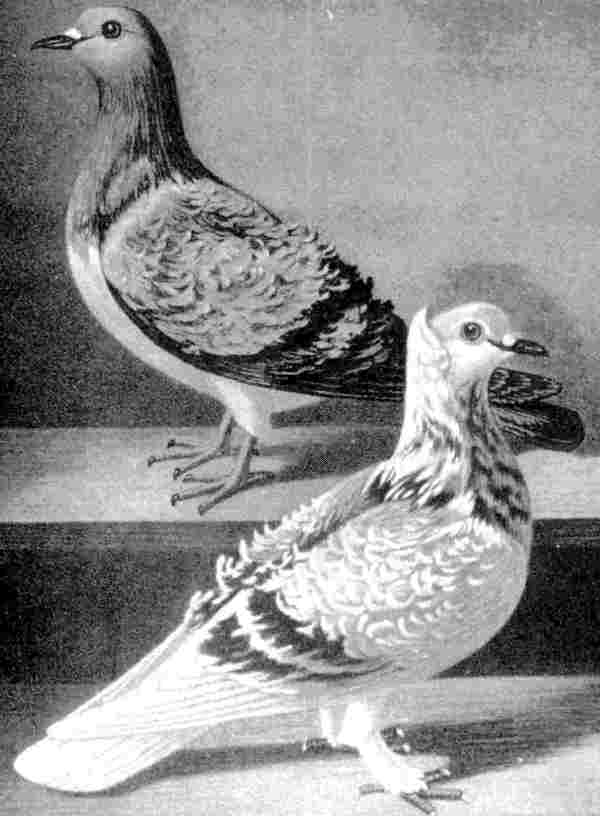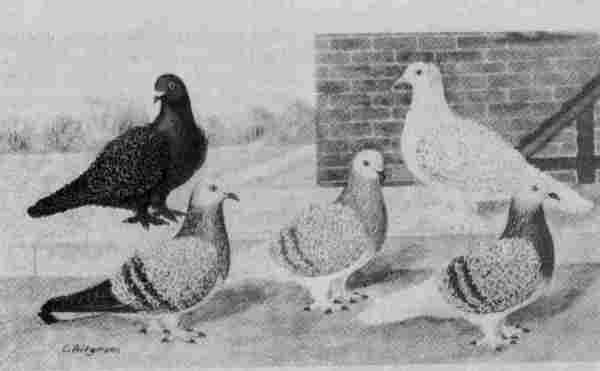
German Pruetz book in the 1800s |
 The modern Frillback as seen today. Top left, black, bluegrizzle yellow grizzle, red grizzle. top right, while crested.
|
From Frizzle To Frillback
by late Guenter Wenzl**

German Pruetz book in the 1800s |
 The modern Frillback as seen today. Top left, black, bluegrizzle yellow grizzle, red grizzle. top right, while crested.
|
The Frillback pigeon has never been as beautiful as it is today. The bird with the permanent curl, loved by pigeon fanciers all over the world, has made great strides of progress in its curl feather development from its frizzlet look some 150 or more years ago. When looking back, it's hard to visualize the input of knowledge of breeders to accomplish the development of a Frillback of such perfection as we see it today.
The
origin of the Frillback is believed to have come from Asia or the southeast of
Europe. As with many
other ancient fancy breeds, the exact origin cannot always
be certain.
Please note the picture of Frillbacks taken from the German Pruetz book in the 1800s. Top bird on shelf, a bluegrizzle, also note that this bird was completely clean legged in that time era. Below is a red grizzle, which displays the shell crest and stocking legs. It was also at that time, the Frillbacks the shell crest and stocking legs. It was also at that time the Frillbacks were already being bred in Germany as well in England. The Frillback also went by a variety of names at that time, such as the lock or curly pigeon, the frizzle pigeon, the pearly or woolen pigeon. Also it was said that some four variations existed (or types), the Hungarian or Austrian Frillback and the French or Dutch Frillback.
The
wing shield feathers differ in shape from that of the wing shield
The
above mentioned types of thx time appeared in plainheads or crested of all
colors. Grizzles and pure white were the most seen but also the shield or saddle
marked had already bee developed and mainly seen in red! Legs were either clean
legged stockings or muffed.
The picture by Oertel and Spoerei Reutlingen West Germany shows you the Frillbacks of today. Top left black, blue grizzle, yellow grizzle, red grizzle, top right, a white crested.
According with today's Standard c Frillbacks in Germany, it is the white variety that is allowed to come either plain headed or shell crested and oni the white shell crested to have medium muff. The white plain heade calls for stockings. Also that a colored varieties should be plain headed and stockings (no muff development).With great enjoyment and muc" honor, 1 have passed judgement on th Frillback pigeon here in the USA fo more than 1 5 years at some o America's leading shows. 1 myself hav shipped Frillbacks from Germany in 1961 to fanciers in America. These bird came from the well known German Frillback breeder, Stepfan Kellermani from Bobingen, Germany. 1 mad, many trips to Mr. Kellermann's lofts ii the 60s and we would sit in th, backyard watching and talking Frillbacks and sipping on a glass of his special homemade wine. Not only did we become good friends, but for me, i was a first class introduction to Frillback knowledge.
In judging and in observing tho development of the Frillback pigeon in America, it would be safe to say tha the quality of the Frillback in America.. is the finest to be found anywhere American fanciers such as Tom Me Caig and perhaps others should always! be remembered for the great achieve, merit that they have made in the develop, merit of Frillback quality to its highest regard.
The American Standard for Frillbacks, as laid out and adopted by the Central Frillback Club is a most unified and complete Standard to be found on the Frillback. This Standard does not only describe the breed itself, but will aid you in so many ways. May it be that of care or show preparations, also some breeding skills are pointed out, which matings to make or which not to make, etc. All of this can be so very important to any fancier that wishes to breed and exhibit Frillbacks. Just to think of the years back in Europe, only the rich and very wealthy could afford to house fancy pigeons, such as the Frillbacks, etc. Today everyone can afford them and of a quality never seen in the old days. The Frillbacks is truly an exhibition breed and deserves its place in the show room. Showing them off to the public, washing away the dirty pigeon image in the eye of the public.
Frillbacks have always reminded me of a strawberry pie with lots of whip- ping cream on top, truly delightful, fancy and of an unusual good taste.
At our last Grand National held in Albuquerque, New Mexico, 1 had the pleasure of judging some 50 beautiful Frillbacks of the Central Frillback Club. Meric Wood, another great breeder of fine Frillbacks, heads this club. Another gentleman in the Frillback world is Jim Armstrong. Jirn features an outstanding monthly column in this APJ called the Frillback Frillies. Many other fanciers have joined the ranks of the Central Frillback Club, names that are still rather new to me, but Frillback quality seems to be apparent in the hands of all of these fanciers. 1 personally would like to thank Merle Wood and the entire Central Frillback Club, also the National Pigeon Assn.
For combined, they have made it possible in honoring me with the judge's certification, again my sincere.
thanks goes out to all of you!in my closing 1 would like to congratulate the Central Frillback Club and all breeders of the Frillback pigeon for having taken up with the Frizzle and with their combined efforts have made the Frillback a most beautiful pigeon of all fancy pigeons. May your efforts continue and fill the show rooms with the fancy curls of the Frillies!
**APJapril1982